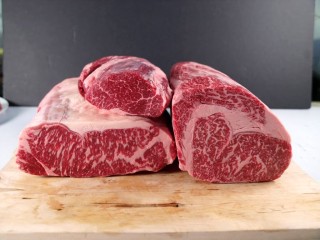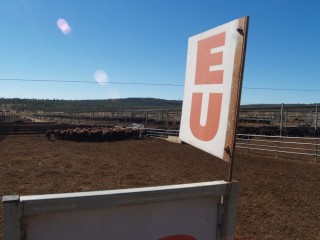 A loophole which is corrupting the EU grainfed beef quota system could jeopardise Australia’s high-value access to the trade just 18 months after it started, unless prompt remedial action can be taken by European authorities.
A loophole which is corrupting the EU grainfed beef quota system could jeopardise Australia’s high-value access to the trade just 18 months after it started, unless prompt remedial action can be taken by European authorities.
The EU grainfed quota was launched with great fanfare early last year, when Australia joined the US as an approved supplier under the program, which has as its star attractions a zero tariff and a 20,000 tonne total access.
In contrast Australia’s pre-existing Hilton High Quality (essentially grassfed) EU quota carries a 20pc tariff, and total country-specific volume of only 7100t. Unlike the grassfed Hilton quota which is awarded on a country-specific basis to countries approved for EU export, the grainfed quota is applied to importers in the EU.
The current problem started in May, when the European Commission changed the rules regarding the allocation of grainfed quota to importers.
The EC elected to open up the quota to all companies that had had experience in importing ‘protein’ into the EU. Previously it was limited to those involved in the Hilton quota beef trade.
Since the EU grainfed trade out of the US and Australia first commenced early last year, there has historically been only 12 or 14 importing companies engaged in the trade.
After the change to regulations, for the July monthly quota allocation (typically 1667t/month), some importers contacted other companies (either inter-related or not) to apply for quota on their behalf, so that they could secure a larger percentage of the allocation.
As the accompanying table at the bottom of this page shows, the allocations went from being moderately oversubscribed each month (applicants received an average 76pc of their requested tonnage over the previous six months) to a situation in July where application requests for a ridiculous 157,864t were received. That meant, on average, each party received just 1.06pc of what they had applied for.
Instead of 20 or 30 European companies applying for quota allocation, as existed previously, suddenly there were 300-plus.
The circumstances have only worsened in total applications for August and September, now blown out to almost 340,000t, meaning each stakeholder is entitled to only 0.49pc of their request.
After the July experience, even more protein import companies saw an opportunity make a ‘fast buck’, and because so many of the original importers had missed out on beef supplies in July, some started paying the ‘speculators’ for access to their allocated quota share. In the latest round of applications for September allocation, it is understood that more than 350 companies made applications.
The purchase price for traded access to EU grainfed quota in July started at €0.1/kg, but has since ballooned to €0.4 and €E0.7/kg. In simple terms, that is worth between A70c and A$1.10/kg, meaning each month’s allocation of 1667t is costing an additional $1.5 million in paper-traded allocation.
Over an annual cycle that currently represents about $18m in opportunistic payments, and exporters say that cost will inevitably be built into meat purchase price, meaning Australian and US exporters will bear the cost, in discounted price.
Matters could only get worse from July 1 next year, when the annual EU grainfed quota is scheduled to increase from 20,000t to 45,000t.
One well-known ‘pioneer’ importer of Australian grainfed product, Paul Van den Meutter has taken a stand in refusing to buy quota from other companies, because to do so would simply encourage other opportunist protein importers to also exploit the system.
His business, Vestey Foods Benelux, based in Belgium, which has built-up supply relationships with retail and food service end-users for Australian product over the past 15 months, is now starved of supply, and is understood to be under considerable stress in terms of its commitments with customers.
Impact on local trade
 The episode’s impact on the Australian stakeholders engaged in the trade has also been catastrophic.
The episode’s impact on the Australian stakeholders engaged in the trade has also been catastrophic.
In some cases, they are diverting the 120-day grainfed product, sourced from expensive EU-eligible cattle and not implanted with HGP into other, less lucrative markets.
Other product is still being exported to the EU, but under the pre-existing Hilton quota (where the importer must pay an additional 20pc in tariff duty).
US exporters servicing the EU grainfed trade are in exactly the same position, sources say.
Unless the European Commission takes some strong and urgent remedial action, the process will continue, Australian export processors and lotfeeders engaged in the trade are suggesting.
Because the tariff-free EU grainfed trade was fundamentally designed as a trade-off with the US over trade disputes, it is seen as most likely that the US will take the lead in any advocacy for change under the current corrupted system. Australia only qualified for the trade after it argued that it, too, could meet the specified requirements based on national grading systems, feed regimes and other criteria.
The US Meat Export Federation is working with the US Government to make a submission to the EU commission advocating for change, and the Australian industry will lend support, putting forward a similar set of arguments.
What is likely to emerge is a proposal that each importer application carry a certificate of authenticity, designed to eliminate participation from any company which has no intention of actively engaging in the trade, and removing the current transferral mechanism activity which is currently corrupting the process.
“While it is not perfect, we believe such a process would remove those companies that are currently speculating on the quota,” said Australian Meat Industry Council EU task force member, Stephen Kelly.
While the EU authorities are understood to be aware of the problem, the EU Commission has been in summer recess recently and little progress has yet been made.
Additionally, the 12 or 14 genuine importer players in the market are being challenged over the structure of the current system by the vast number of others who simply want to exploit the opportunity.
“The impact is dramatic, and it is such as shame that the EC can’t stop all these speculators from entering the process and destroying what has been a fantastic new trade for Australia,” Mr Kelly said.
Given the bureaucratic processes that apply in EU decision-making, can any remedial action be taken in time to save the trade?
Mr Kelly said in the case of his company, Nippon Meat Packers Australia, it had taken a position of continuing to source eligible feeder cattle in anticipation that there would be some form of resolution.
“At this stage, we’re anticipating a solution being found, because if nothing happens, this whole grainfed EU quota could simply implode, which would be a tragedy for the Australian beef industry,” he said.
Under the current quota agreement, the US has the right to withdraw, meaning that if the EC does not fix the problem, the US is well within its rights to simply walk away and re-activate all its previous trade sanctions and retaliatory tariffs against the EU over the original dispute over HGP-use.
“That’s where the pressure will come from, from within the US,” Mr Kelly said.
“Other eligible suppliers like Australia and Uruguay will not be able to solve the dilemma as quickly or decisively s the US might,” he said.
